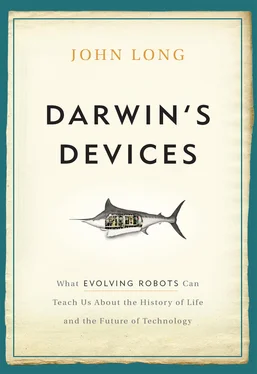THE SYNTHETIC APPROACH OF EMBODIED ROBOTICS
This synthetic approach underlies what Rohlf Pfeifer and Christian Scheier call embodied cognitive science or embodied artificial intelligence, and it is at the core of the defense of robots I offered earlier: build embodied robots that behave as autonomous agents. The behavior that these agents create can then be understood on the basis of their physical design, programming, and interaction with the physical world. If we can build it, then we understand it.
I should mention that although this synthetic approach with embodied robots is new to biology, physical models have been used to great effect for some time. Vogel, the biomechanics professor from Duke University, pioneered the use of physical models to test ideas about which engineering principles nature is exploiting in organisms. One of Vogel’s and Wainwright’s former students, Mimi Koehl, a biomechanics professor at the University of California, Berkeley, is world famous for building physical models of animals—both living and extinct—to test ideas about the functional principles in operation. Physical models have a lot going for them.
* You can build a simplified version of an organism or its part.
* You can enlarge or reduce the size of the part or the organism.
* You can isolate and change single parts, keeping all else constant.
* You can reconstruct extinct organisms.
For Koehl physical models complement experiments with both real organisms and computer models. Although we’ve talked about the limits of experiments on real organisms, like marlin, it’s worth mentioning briefly here some of the problems with computer models. As many of us have learned, computer models are fantastic when you can represent the biological phenomena you are modeling in well-formed equations or even clunkier but still serviceable numerical recipes. Beautiful is the clean-line output, perhaps cloaked with a surface function painted in a million hues of color, of a computer model to the abstract-art–trained eyes of a scientist. But to get that elegant output, we always have to make, even in the most accurate models, many simplifying assumptions. The trick is to make the right ones.
My first step when experiments with marlin left me at the end of my conceptual tether was to create a computer model. From my biomechanical tests I had derived equations of motion that described the torque needed to bend each joint and the resulting angular motion. My initial assumption was that these equations were sufficient to describe the mechanical behavior of the backbone in a swimming marlin. I simplified the backbone mathematically to a series of equations that were linked by the bending torques that we imposed on one and then another joint. I assumed that muscles and water resistance were acting to create the torques being transmitted up and down the backbone. With these assumptions and simplifications, I created a beautiful animation of an undulating backbone passing waves of bending from head to tail.
I presented this model to the department as the capstone of my PhD research. After the talk a fellow graduate student, Matt Healy, hurried up to me and said, in a concerned hush, “You’ve got a problem. I just heard Vance Tucker say that you may have violated the laws of physics.” This was the equivalent of saying, “A god-like scientist thinks you’ve made a huge mistake and your reputation and career are in immediate jeopardy”—gulp. Tucker, a physiologist working in the physically messy world of bird flight by using brilliant flow-tunnel experiments and engineering theory, was another one of Duke’s biomechanics gurus. I immediately shuffled to his downstairs office.
In response to my knock Tucker looked up from his lab bench and, with a flash of recognition, said, “Come in.” Terse understatement—bad sign. I’m in worse trouble than I thought , I said to myself. I sat down and, unable to bear any longer my impending professional death, pointed right to the sword of Damocles hanging over my head, saying, “I heard that you think I violated the laws of physics?” His response was gracious and careful. Understanding the close proximity of his criticism to my forthcoming dissertation defense, he reminded me that the model I had presented was but one of five chapters in my thesis. Its problems were, by themselves, unlikely to overturn any experimental results because the experiments were independent of the model. And, he offered, he hadn’t seen for himself the model chapter. “But,” he finished, “it appears to me that you’ve created a perpetual motion machine.”
Tucker was right, and I knew it immediately. My various assumptions and simplifications allowed me to create a model that violated the Second Law of Thermodynamics. I had assumed and simplified away energy input and loss so that my backbone, once bent, would continue undulating away forever.
It turns out that this kind of violation of reality is not so uncommon: years later a master of physical modeling and bioinspired design, Charles Pell, would say to me, “Every computer model is doomed to succeed.” Any computer modeler can always create beautiful output even if the physics of the model were wrong. This giant pitfall of the naive computer modeler (ahem, yes, that was me) is the reason that researchers like Pell, Koehl, and Vogel are careful to build physical models. As Pell said to me at another time: “Physical models can’t violate the laws of physics.” If an engineer’s design violates the laws of physics, the machine won’t go on forever: instead, it just won’t go. So we now have a fifth reason to use physical models and not digital ones to understand biological systems. This reason is so important, however, that I will make it point number one:
* You can’t violate the laws of physics.
* You can build a simplified version of an animal.
* You can change the size of the animal.
* You can isolate and change single parts, keeping all else constant.
* You can reconstruct extinct animals.
Do not read this, please, as saying that all computer models violate the laws of physics. Many, many computer models accurately model the physics of the world. You just have to be careful and skilled about which simplifications and assumptions to make.
For my part I’ve realized that the mathematical representation of the biology and physics of swimming fish is, as some say, “nontrivial.” In fact, for a long time many research labs around the world have been working on the hydrodynamics of flexible bodies, like fish, interacting with a surrounding fluid. The applied mathematician James Lighthill was knighted in 1971 for his efforts, which, among other things, describe how a fish creates thrust. Today, teams of biologists, fluid dynamicists, mathematicians, and computer scientists attempt to couple the physics of fluid with that of muscle and connective tissue. Nontrivial, indeed. Robert Root and Chun Wai Liew, both of Lafayette College, and I collaborate on this front, and because of their expertise, I am happy to report that I’m no longer accused of building computer models that violate the laws of physics. In terms of how they represent the physical world, the computer models that we make are not as complex as a robot. Although our computer models of swimming fish are two-dimensional, our fish-like robots are three-dimensional. Our computer models of swimming fish have a lower speed limit, below which Lighthill’s thrust equations don’t work; our fish-like robots can slow down and even stop. Further proof of Rodney Brooks’s dictum: “The world is its own best model.” If you want to be sure that your model hasn’t left out any important physics, the best thing to do is to build it in the real world.
We can now revise our list of reasons to use physical models, here adding reasons based on what we know about autonomous robots. With physically embodied robots built to model animals,
Читать дальше












